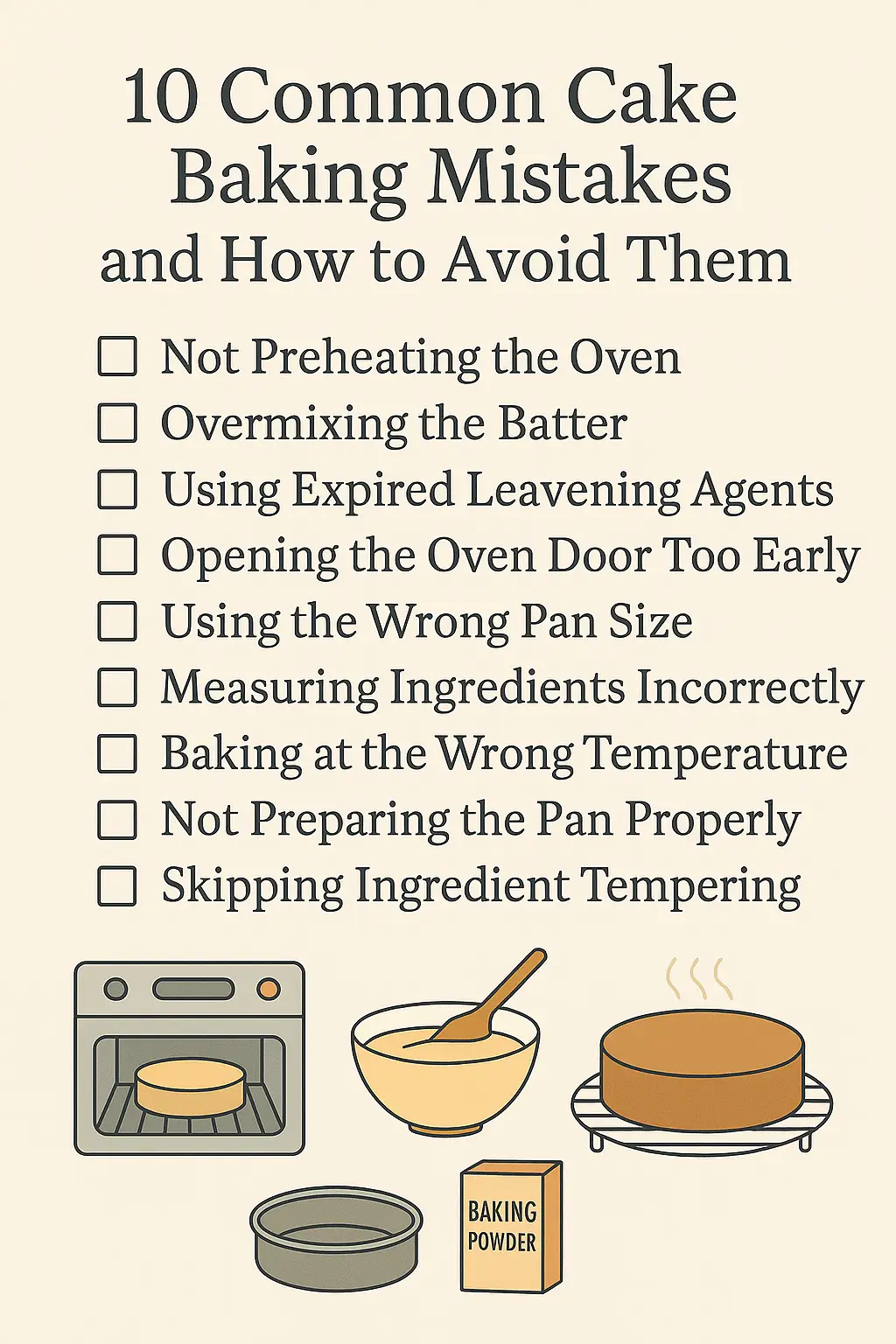Introduction
Baking a cake seems simple: mix ingredients, put it in the oven, and wait for magic to happen. But anyone who has tried and ended up with a dense, dry, or sunken cake knows that it’s easy to go wrong. Even experienced bakers can make mistakes that affect texture, flavor, and appearance.
The good news? Most cake disasters are completely avoidable if you understand the common pitfalls and know how to fix them. In this guide, we’ll explore 10 of the most frequent cake baking mistakes and share practical solutions so you can achieve soft, fluffy, and delicious cakes every single time.
Mistake 1: Not Preheating the Oven
Putting your cake into a cold oven is a recipe for disaster. The leavening agents (baking powder, baking soda) start working as soon as they come in contact with liquid and heat. If the oven isn’t hot enough when the cake goes in, it won’t rise properly.
How to Avoid It: Always preheat your oven to the exact temperature specified in the recipe, usually for at least 10–15 minutes before baking. An oven thermometer is essential to check accuracy.
Mistake 2: Overmixing the Batter
Mixing too much after adding flour can overdevelop gluten, resulting in a dense, chewy cake instead of a light and fluffy one.
How to Avoid It: Once you’ve added dry ingredients, mix only until they are just incorporated. It’s fine if the batter has a few small lumps — they will disappear during baking.
Mistake 3: Using Expired Leavening Agents
Old baking powder or baking soda won’t provide enough lift, leaving your cake flat and heavy.
How to Avoid It: Check expiration dates regularly. You can test baking powder by mixing ½ teaspoon into ¼ cup of hot water — it should fizz immediately. For baking soda, mix ½ teaspoon into ¼ cup of vinegar — it should bubble vigorously.
Mistake 4: Opening the Oven Door Too Early
Opening the oven during the first half of baking causes heat loss, which can make the cake sink in the middle.
How to Avoid It: Resist the urge to peek. Only open the door when you’re near the end of the baking time to check for doneness.
Mistake 5: Using the Wrong Pan Size
Using a pan that’s too small can cause overflow; too large and your cake may bake too quickly and dry out.
How to Avoid It: Follow the recipe’s recommended pan size. If you must substitute, adjust the baking time accordingly.
Mistake 6: Measuring Ingredients Incorrectly
Too much flour can make a cake dry, and too much sugar can cause collapse.
How to Avoid It: For dry ingredients, spoon into the measuring cup and level off. For liquids, use a transparent measuring cup and check at eye level. For the best accuracy, use a kitchen scale.
Mistake 7: Baking at the Wrong Temperature
An oven that’s too hot can cause the cake to dome and crack, while one that’s too cool can make it dense and undercooked.
How to Avoid It: Use an oven thermometer to verify the temperature. Adjust racks so the cake is in the center of the oven.
Mistake 8: Not Preparing the Pan Properly
If you skip greasing or lining the pan, your cake might stick and break apart when you try to remove it.
How to Avoid It: Grease the pan with butter or cooking spray, dust with flour, and use parchment paper for extra security.
Mistake 9: Skipping Ingredient Tempering
Cold eggs, butter, or milk don’t mix evenly and can create a curdled batter.
How to Avoid It: Bring all ingredients to room temperature before mixing — usually about 30–60 minutes.
Mistake 10: Ignoring Cooling Time
Removing a cake from the pan too soon can cause it to fall apart; frosting while warm can make the icing melt.
How to Avoid It: Let the cake cool in the pan for 10–15 minutes before removing it. Always cool completely before decorating.
Bonus Tips for Flawless Cakes
- Use room-temperature butter for better creaming with sugar.
- Weigh ingredients for perfect consistency every time.
- Avoid overbaking — start checking 5 minutes before the suggested time.
Frequently Asked Questions (FAQ)
Q: How do I fix a dry cake?
A: Brush with simple syrup (equal parts sugar and water, boiled and cooled) to add moisture.
Q: Can I rebake a cake that’s undercooked?
A: Yes, if it’s still hot. Place it back in the oven immediately.
Q: Why did my cake sink in the middle?
A: Common causes include opening the oven too early, expired leavening agents, or underbaking.
Q: How do I store a cake to keep it fresh?
A: Wrap in plastic wrap and store at room temperature for up to 3 days, or refrigerate if frosted with perishable icing.
Conclusion
Baking a cake is about more than just following a recipe — it’s about understanding how each step affects the final result. By avoiding these 10 common mistakes and applying the solutions above, you’ll set yourself up for success every time you bake.

